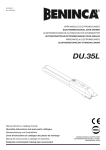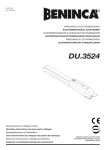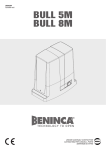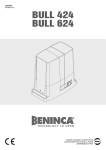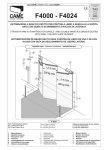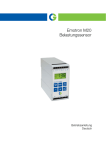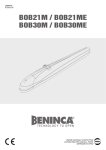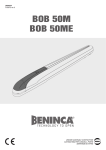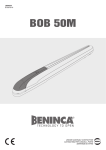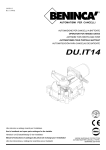Download DU.35V - JCCOM
Transcript
L8542474 12/2009 rev 1 DU.35V UNIONE NAZIONALE COSTRUTTORI AUTOMATISMI PER CANCELLI, PORTE SERRANDE ED AFFINI 2 Dimensioni d’ingombro / Overall dimensions / Abmessungen Dimensions d’encombrement / Dimensiones exteriores / Wymiary gabarytowe * Corsa. Stroke. Hub. Course. Carrera. Posuw. 350 * 354 820 92 136 1 Arresto in chiusura - indispensabile. Stop when closing - essential. Endanschlag zur Schließung - unerläßlich. Arrêt en fermeture - indispensable. Tope de cierre indispensable. Zatrzymanie przy zamykaniu; obowiązkowo. Arresto in apertura (necessario se non si usa il F. C.). Stop when opening (necessary if not using the limit stop). Endanschlag zur Öffnung (nötig, wenn kein Endschalter benutzt wird). Arrêt en ouverture (arrêt en ouverture nécessaire si on n’utilise pas le F.C.). Tope en apertura (necesario si no se usa el F.C.). Zatrzymanie przy otwieraniu (konieczne, jeżeli nie używa się wyłącznika krańcowego) 3 2A V K X Z Y M P Apertura max. Tempo apertura 90° Max. opening Opening time Max. Öffnung Öffnungszeit X Ouverture max. Y Abiertura max. Z min. K M* max Otwarcie maks. Tiempo de abiertura Czas otwierania 110° 105 110° 130 90° 165 105 130 165 70 90 110 585 50 560 530 75 100 * N.B.: La quota M max. è riferita ad una quota V= 50 mm * N.B.: The dimension M max. refers to a dimension V= 50 mm * N.B.: Das Maß M max. bezieht sich auf ein Maß V= 50 mm * N.B.: La cote M max. est référée à une cote V= 50 mm * N.B.: La cota M máx. hace referencia a la cota V= 50 mm * N.B.: Wymiar M max odnosi się do parametru V = 50 mm 2B U 4 Temps d’ouverture 13" 16" 21" Dimensioni max. anta Max. wing dimensions Max Flügelmasse Dimens. max. de la porte Dimens. max. de la hoja Maks. wymiary skrzydła L (m) P (kg) 2 300 2,5 200 2 400 2,5 300 3 200 3 300 S P 3A S P 3B Vite Ø3.9. Screw Ø3.9. Schraube Ø3.9. Vis Ø3.9. Tornillo Ø3.9. Sruba Ø3.9. R M V S P P U F D Mettere a livello. Level. Nivellieren. Mettre de niveau. Nivelar. Uliniować T S 5 4A 4B F1 F1 COM COM C F2 F2 C F1 F2 C 4 5 6 COM FCO FCO FCO 1 GND F1 2 3 F2 COM 4 5 6 GND 1 2 3 4 1 F1 F2 COM 5 2 F1 FCOF2 6 3 4 5 GND FCO COM 5 D T Posticipa. Postpone. Anziehen. Diffère. Atrasa. Opóźnienie Anticipa. Advance. Verlangsamt. Anticipe. Adelanta. Wyprzedzenie F.C. apertura Opening limit stop Öffnungsendschalter Fin de course d’ouverture F.C. apertura Wył. krańc. otwierania marrone: F.C. apre brown: limit stop opens brauner Draht: Endschalter richtung ”Tor-auf” marron: le fin de course ouvre marron: F.C. abrir Brązowy: Wył- krańc. otwierania blu: comune F.C. blue: limit stop common blauer Draht: gemeinsamer Erdung bleu: fin de course commun azul: comun F.C. Granatowy: Wspólny wył. krańc. F 6 6 GND 6 C Spostare nel senso della freccia. Move arrowise. In Pfeilrichtung schieben. Déplacer dans le sens de la flèche. Desplazar en el sentido de la flecha. Przesunąć w kierunku strzałki Tirare. Pull. Ziehen. Tirer. Tirar. Ciągnąć Premere. Press. Drücken. Pousser. Presionar. Wcisnąć Inserire e ruotare di 90°. Insert and rotate by 90°. Einstecken und um 90° drehen. Insérer et tourner de 90°. Insertar y girar 90°. Wprowadzić i obrócić o 90°. P Farla ruotare fino sentire lo scatto. Rotate till the click. Drehen, bis man es schnappen hört. La faire tourner jusqu’à obtention du déclic. Hacerla girar hasta sentir el golpecillo de desbloqueo. Obracać aż do usłyszenia dźwięku wskazującego zadziałanie urządzenia. P 7 Collegamenti elettrici / Wire diagram / Elektrische Anschlüsse Branchements électriques / Conexiones eléctricas / Połączenia elektryczne 4 5 0,3 2x 2x0,35 2x1,5 3 1 2x 2 1,5 4x 5 Legenda: 1 Motoriduttore DU.35V 2 Fotocellule SC.P50 (da incasso), SC.P50E (da esterno) 3 Selettore a chiave ID.SC o ID.SCE (da esterno) o tastiera digitale ID.PTD 4 Lampeggiante ID.LUX 5 Antenna LO.E1N (superreattiva) o LO.E1LUX (quarzata) 6 Centrale elettronica DA.93A Legenda: 1 Motoreducer DU.35V 2 Photo-electric cells SC.P50 (built in), SC.P50E (external) 3 Key selector ID.SC or ID.SCE (external) or digital keyboard ID.PTD 4 Flash-light ID.LUX 5 Antenna LO.E1N (superreactive) or LO.E1LUX (quartz) 6 Electronic gearcase DA.93A RG 58 1 1 1,5 1 2x 4x 5 0,3 2 4x n mi 1,5 c 3x 30Va 2 6 Zeichenerklärung: 1 Getriebemotor DU.35V 2 Fotozelle SC.P50 (eingelegt), SC.P50E (außenliegend) 3 Schlüssel-Selektor ID.SC oder ID.SCE (außenliegend) oder Digital-Tastatur ID.PTD 4 Blinker ID.LUX 5 Antennne LO.E1N (Superreaktiv) oder LO.E1LUX (Quartz) 6 Elektroschrank DA.93A Légende: 1 Moteur-réducteur DU.35V 2 Photocellule SC.P50 (noyée) - SC.P50E (d’extérieur) 3 Selecteur à clé ID.SC ou ID.SCE (d’extérieur) ou clavier digital ID.PTD 4 Clignotant ID.LUX 5 Antenne LO.E1N (super-active) ou LO.E1LUX (au quartz) 6 Centrale électronique DA.93A Leyenda: 1 Motorreductor DU.35V. 2 Fotocélulas SC.P50 (de empotrar), SC.P50E (de superficie). 3 Selectores a llave ID.SC o ID.SCE (de superficie). 4 Relampagueador ID.LUX. 5 Antena LO.E1N (superreactiva) o LO.E1LUX (cuarzada). 6 Central electrónica DA.93A. Legenda: 1 Siłownik DU.35V 2 Fotokomórki SC.P50 (wbudowane), SC.P50E (zewnętrzne) 3 Wyłącznik kluczowy ID.SC lub ID.SCE (zewnętrzny) lub elektroniczna tablica rzyciskowa ID.PTD 4 Lampa migocąca ID.LUX 5 Antena LO.E1N (superczuła) lub LO.E1LUX (kwarcowa ) 6 Centralka elektroniczna DA.93A 8 N.B.: Tenere separati i cavi di potenza da quelli ausiliari. N.B.: The power cables must be kept separated from the auxiliary cables. Wichtig: Leistungskabel von Hilfskabeln getrennt halten. N.B.: Séparer les câbles de puissance des câbles auxiliaires. N.B.: Tener separados los cables de potencia de los auxiliares. Uwaga: należy trzymać w oddali przewody zasilania od przewodów pomocniczych. Dichiarazione CE di conformità per macchine (Direttiva 98/37 CE, Allegato II, parte B) - Divieto di messa in servizio Fabbricante: Automatismi Benincà SpA. Indirizzo: Via Capitello, 45 - 36066 Sandrigo (VI) - Italia Dichiara che: l’automazione per cancelli a battente modello DU.35V. • è costruita per essere incorporata in una macchina o per essere assemblata con altri macchinari per costituire una macchina considerata dalla Direttiva 98/37 CE, come modificata; • non è dunque conforme in tutti i punti alle disposizioni di questa Direttiva; • è conforme alle condizioni delle seguenti altre Direttive CE: Direttiva bassa tensione 73/23/CEE, 93/68/CEE. Direttiva compatibilità elettromagnetica 89/336/CEE, 93/68/CEE. e inoltre dichiara che non è consentito mettere in servizio il macchinario fino a che la macchina in cui sarà incorporata o di cui diverrà componente sia stata identificata e ne sia stata dichiarata la conformità alle condizioni della Direttiva 98/37 CE e alla legislazione nazionale che la traspone, vale a dire fino a che il macchinario di cui alla presente dichiarazione non formi un complesso unico con la macchina finale. Benincà Luigi, Responsabile legale. Sandrigo, 08/04/2008. AVVERTENZE E' vietato l'utilizzo del prodotto per scopi o con modalità non previste nel presente manuale. Usi non corretti possono essere causa di danni al prodotto e mettere in pericolo persone e cose. Si declina ogni responsabilità dall'inosservanza della buona tecnica nella costruzione dei cancelli, nonché dalle deformazioni che potrebbero verificarsi durante l'uso. Conservare questo manuale per futuri utilizzi. L'installazione deve essere effettuata da personale qualificato nel pieno rispetto delle normative vigenti. I materiali dell'imballaggio non devono essere lasciati alla portata dei bambini in quanto fonte di potenziale pericolo. Non disperdere nell'ambiente i materiali di imballo, ma separare le varie tipologie (es. cartone, polistirolo) e smaltirle secondo le normative locali. L’installatore deve fornire tutte le informazioni relative al funzionamento automatico, manuale e di emergenza dell'automazione, e consegnare all’utilizzatore dell’impianto le istruzioni d’uso. • Prevedere sulla rete di alimenta zione un interr u t to r e /s e z i o n a to r e o n n i p o l a r e c o n d i s t a n z a d’apertura dei contatti uguale o superiore a 3 mm. Verificare che a monte dell’impianto elettrico vi sia un interruttore differenziale e una protezione di sovracorrente adeguati. Alcune tipologie di installazione richiedono il collegamento dell'anta ad un impianto di messa a terra rispondente alle vigenti norme di sicurezza. Durante gli interventi di installazione, manutenzione e riparazione, togliere l’alimentazione prima di accedere alle parti elettriche. Le descrizioni e le illustrazioni presenti in questo manuale non sono impegnative. Lasciando inalterate le caratteristiche essenziali del prodotto il fabbricante si riserva il diritto di apportare qualsiasi modifica di carattere tecnico, costruttivo o commerciale senza impegnarsi ad aggiornare la presente pubblicazione. 9 Introduzione Ci congratuliamo con voi per aver scelto il motoriduttore DU.35V. Tutti gli articoli della vasta gamma Benincà sono il frutto di una ventennale esperienza nel settore degli automatismi e di una continua ricerca di nuovi materiali e di tecnologie all’avanguardia. Proprio per questo, oggi siamo in grado di offrire dei prodotti estremamente affidabili che, grazie alla loro potenza, efficacia e durata, soddisfano pienamente le esigenze dell’utente finale. Tutti i nostri prodotti vengono costruiti in conformità alle norme vigenti e sono coperti da garanzia. Inoltre, una polizza R.C. prodotti stipulata con primaria compagnia assicurativa copre eventuali danni a cose o persone causati da difetti di fabbricazione. Notizie generali Per un buon funzionamento delle automazioni in oggetto, il cancello da automatizzare dovrà rispondere alle seguenti caratteristiche: - buona robustezza e rigidità - le cerniere devono presentare giochi minimi e permettere che le manovre manuali siano dolci e regolari - in posizione di chiusura le ante devono combaciare fra loro per tutta l’altezza. F1 F2 COM 4. CABLAGGI Apre Chiude Comune motore Fig. 4A - Cablaggio standard - il finecorsa di apertura (FCO) interrompe la fase motore. Fig.4B - Per collegare il finecorsa di apertura (FCO) alla centrale modificare i collegamenti come indicato. 5. Regolazione finecorsa Per la regolazione del finecorsa in apertura procedere come segue (fig.5): • togliere il tappo T • agire quindi sul dado D mediante una chiave esagonale a tubo da 10mm; ruotarlo in senso orario per anticipare l’intervento del finecorsa F, viceversa per posticiparlo. 1. Caratteristiche generali Semplice ed affidabile può essere installato su qualsiasi cancello a battente fino a max. 3m per anta. Armonico ed elegante è costruito interamente in alluminio. Il gruppo di riduzione robusto e ben collaudato lo rende affidabile e silenzioso. È inoltre dotato di finecorsa molto semplici e pratici da regolare e di sblocco d’emergenza a chiave personalizzata. 6. Sblocco e manovra manuale Come gli altri automatismi della gamma Benincà, anche il DU.35V è dotato di uno sblocco semplice e funzionale che permette la manovra manuale in assenza di energia elettrica. Per sbloccare l’automatismo procedere come segue (fig. 6): • spostare il copriserratura C nel senso della freccia fino a vedere quest’ultima. • Inserire la chiave personalizzata e ruotarla di 90°. • Premere sul lato posteriore della portina P ed, aiutandosi poi tirandola dalla parte anteriore, farla ruotare fino a sentire lo scatto. Per ripristinare il funzionamento abbassare la portina; la prima manovra ripristinerà il normale funzionamento. N.B.: Se non si utilizza il finecorsa in apertura, è consigliabile portare il cancello in posizione prossima alla chiusura prima di ripristinare il funzionamento automatico. 2. Arresti meccanici È indispensabile che il portone da automatizzare disponga di un arresto meccanico in chiusura; l’arresto meccanico diventa necessario anche in apertura quando non viene utilizzato l’apposito F.C (fig. 1). ATTENZIONE La polizza RC prodotti, che risponde di eventuali danni a cose o persone causati da difetti di fabbricazione, richiede la conformità dell’impianto alla normativa vigente e l’utilizzo di accessori originali Benincà. 3. Messa in posa dell’automatismo 3.1. Stabilire l’altezza dal suolo dell’automatismo (si consiglia il più centrato possibile rispetto al portone ed in corrispondenza di un solido traverso). Fissare quindi la piastra P utilizzando le quattro viti M12 (in dotazione) rispettando le quote di fig. 2A (potrebbe essere necessario cambiare la posizione dello snodo posteriore U come in figura 2B). 3.2. Con il portone in chiusura, fissare la staffa S con due viti M10 (in dotazione) allo stesso livello della piastra P ad un traverso del portone o ad altro elemento adeguatamente robusto; tener presente che in questa condizione il pistone non deve essere totalmente a fine corsa (fig. 3A). • Togliere quindi il riparo R ed il supporto morsettiera M (fig. 3B). • Inserire l’attuatore sul perno della staffa S. • Inserire lo snodo posteriore U sulla piastra P ed inserirvi il perno V. • Bloccare quest’ultimo con il dado autobloccante D. Serrare infine la vite T. Nota: È possibile accedere con il cavo di alimentazione dalla parte inferiore dell’automatismo tramite uno dei due fori ivi predisposti; in questo caso usufruire del foro F sulla piastra indicato in figura 3B e fare attenzione che l’automatismo si fermi prima di tranciare il cavo. 10 Dati tecnici Alimentazione Potenza assorbita Corrente assorbita Spinta Classe isolamento Temper. funzionamento Rumorosità Condensatore Lubrificazione Corsa standard Peso DU.35V 230 Vac 310 W 1,4 A 2000 N F -20°C / +70°C <70 dB 9 µF Molykote Longterm 2 plus 350 mm 10 kg EC Declaration of Conformity regarding machines (Directive 98/37 CE, Annex II B) - No servicing Manufacturer: Automatismi Benincà SpA. Address: Via Capitello, 45 - 36066 Sandrigo (VI) - Italia Herewith declares that: the operator for hinged gates model DU.35V. • is intended to be incorporated into a machine or assembled together with other devices to form a machine in compliance with the EC Directive 98/37, as amended; • therefore, is not in every respect complying with this Directive; • is complying with provisions set forth by the following other EC Directive: EC Low voltage Directive (73/23/EEC, 93/68/EEC). EC Directive of Electromagnetic Compatibility (89/336/EEC, 93/68/EEC) Moreover, we herewith declare that the system shall not be put into service until the machine in which the same will be incorporated or of which it will become a component, is acknowledged compliant with the EC Directive 98/37 and applicable national legislation and a related declaration of conformity is drawn up. In other words, no servicing shall be carried out until the system under this declaration does not form one single final machine with other components. Benincà Luigi, Legal responsible. Sandrigo, 08/04/2008. WARNING The product shall not be used for purposes or in ways other than those for which the product is intended for and as described in this manual. Incorrect uses can damage the product and cause injuries and damages. The company shall not be deemed responsible for the noncompliance with a good manufacture technique of gates as well as for any deformation, which might occur during use. Keep this manual for further use. Qualified personnel, in compliance with regulations in force, shall install the system. Packaging must be kept out of reach of children, as it can be hazardous. For disposal, packaging must be divided the various types of waste (e.g. carton board, polystyrene) in compliance with regulations in force. The installer must supply all information on the automatic, manual and emergency operation of the automatic system and supply the end user with instructions for use. • An omnipolar switch/section switch with remote contact opening equal to, or higher than 3mm must be provided on the power supply mains.. Make sure that before wiring an adequate differential switch and an overcurrent protection is provided. Pursuant to safety regulations in force, some types of installation require that the gate connection be earthed. During installation, maintenance and repair, cut off power supply before accessing to live parts. Descriptions and figures in this manual are not binding. While leaving the essential characteristics of the product unchanged, the manufacturer reserves the right to modify the same under the technical, design or commercial point of view without necessarily update this manual. 11 Introduction Thank you for choosing our DU.35V ratiomotor. All items in the wide Benincà production range are the result of twenty-years’ experience in the automatism sector and of continuous research for new materials and advanced technologies. We are, therefore, in the position to offer higly reliable products that due to their power, effectiveness and useful life, fully satisfy the final user’s requirements. All our products are manufactured to the existing standard and are covered by warranty. Possible injury to people or accidents caused by defects in construction are covered by a civil liability policy drawn up with one of the major insurance companies. General information For an efficient operation of these automatisms, the gate must have the following features: - good stoutness and stiffness - all hinges must have positive clearances and permit smooth and regular manual operations. - when wings are closed their height have to fit together. 1. General features The DU.35V electromechanical gate opener is simple and reliable and can be installed onto any swing-gate having up to 3m max wings. Harmonious and elegant it is made entirely in aluminium. The stout and well tested reduction unit makes it reliable and noiseless. It is also equipped with simple and easily adjustable limit stops and an emergency release with personalised key. 2. Mechanical stops It is necessary that the gate to be automatised has got a mechanical stop when closing; this mechanical stop becomes necessary also when opening in case the suitable limit stop is not used (fig. 1). 3. Automatism positioning 3.1. Fix the distance from the ground of the automatism has (it is advisable it is in the middle of the gate and possibly close to a strong ledger). Fit the P plate by using the four M12 screws (supplied) according to measures shown in fig. 2A (it might be required to change the position of the upper U articulation, as per figure 2B). 3.2. With the door in the closing phase, fix the S bracket with the M10 screws (supplied) at the same level of the P plate to a beam of the man door or other adequately rugged element. Keep in mind that, in this condition, the piston must not be entirely in the end-stroke position (fig. 3A). • Remove then the protection R and the terminal board support M (fig. 3B). • Insert the back articulated joint U onto the plate P and insert the pivot V. Tighten the pivot through the self-blocking nut D. • Tighten now the screw T. Note: the power supply cable can be introduced into the lower part of the automatism, by means of one of the two holes situated there. If this is the case, use the plate hole F indicated in the figure 3B and make sure that the automatism stops before cutting the cable. 12 F1 F2 COM 4. CONNECTIONS Open Close Motor common wire Fig. 4A – Standard wiring - the opening limit switch (FCO) interrupts the motor phase. Fig. 4B – To connect the opening limit switch (FCO) to the control unit, modify the connections as indicated. 5. Limit stop adjustment For the limit stop adjustment when opening, proceed as follows (fig.5): • remove cap T • loosen nut D by means of a 10mm hexagon head socket spanner; turn the nut clockwise to advance the triggering of the limit switch F and anticlockwise to postpone triggering. 6. Release and manual move As all the other automatisms in the Benincà production range, also the DU.35V has a simple and functional release which permits the manual move when there is no electricity. To release the automatism, please proceed as follows (fig. 6): • Move the lock-cover C until the arrow is visible. • Insert the personalised key and rotate it by 90°. • Press onto the back side of the door P and rotate it to a click by pulling from the front side. In order to make it run again, lower the small door; the first manoeuvre will re-establish the manual operation. P.N.: if the opening limit stop is not used, it is advisable to bring the gate in a position close to the closing one before re-establishing the automatic running. CAUTION The civil liability policy, which covers possible injuries to people or accidents caused by defects in construction, requires the system to be to existing standard and to use original Benincà accessories. Technical data Power supply Absorbed rating Absorbed current Thrust Insulation class Operating temperature Noise level Capacitor Lubrication Standard stroke Weight DU.35V 230 Vac 310 W 1,4 A 2000 N F -20°C / +70°C <70 dB 9 µF Molykote Longterm 2 plus 350 mm 10 kg EG-Konformitätserklärung für Maschinen (Richtlinie 98/37 EG, Anhang II, Teil B) – Inbetriebsetzen verboten Hersteller: Automatismi Benincà SpA. Adresse: Via Capitello, 45 - 36066 Sandrigo (VI) - Italia Wir erklären, dass: Antriebe für Drehflügeltore DU.35V. • hergestellt worden ist, um in Maschinen eingebaut oder in Verbindung mit anderen Maschinen verwendet zu werden, wodurch die Maschine laut EG-Richtlinie 98/37 als umgeändert gilt; • die Automation entspricht daher nicht allen Punkten der Vorschriften dieser Richtlinie; • sie entspricht folgenden EG-Richtlinien: Niederspannungs-Richtlinie 73/23/EWG, 93/68/EWG. Richtlinie über die elektromagnetische Verträglichkeit 89/336/EWG, 93/68/EWG. Wir erklären zudem, dass die Maschine/Anlage in welche oder in Verbindung mit welcher die Automation installiert wird, nicht in Betrieb gesetzt werden darf, bis sie identifiziert und laut EG-Richtlinie 98/37 sowie laut den nationalen Gesetzen, die zur Umsetzung der EG-Richtlinie erlassen wurden, als konform erklärt worden ist. Die hier genannte Automation muss daher mit der Maschine als ein Ganzes als konform erklärt werden. Benincà Luigi, Rechtsvertreter Sandrigo, 08/04/2008. HINWEISE Das Produkt darf nicht für andere Zwecke oder auf andere Weise verwendet werden, als in der vorliegenden Anleitung beschrieben. Ein ungeeigneter Gebrauch kann das Produkt beschädigen und eine Gefahr für Personen und Sachen darstellen. Wir übernehmen keinerlei Haftung für Schäden, die sich aus einer unsachgerechten Montage der Tore und aus daraus folgenden Verformungen ergeben können. Bewahren Sie dieses Handbuch für Nachschlagzwecke auf. Die Installation darf nur von qualifizierten Fachleuten laut den geltenden Vorschriften vorgenommen werden. Das Verpackungsmaterial fern von Kindern halten, da es eine potentielle Gefahr darstellt. Das Verpackungsmaterial nicht ins Freie werfen, sondern je nach Sorte (z.B. Pappe, Polystyrol) und laut den örtlich geltenden Vorschriften entsorgen. Der Installateur hat dem Benutzer alle Informationen über den automatischen, manuellen Betrieb sowie den Not-Betrieb der Automatik zusammen mit der Bedienungsanleitung zu liefern. • Das Stromnetz muss mit einem allpoligen Schalter bzw. Trennschalter ausgestattet sein, dessen Kontakte einen Öffnungsabstand gleich oder größer als 3 aufweisen.. Kontrollieren, ob der elektrischen Anlage ein geeigneter Differentialschalter und ein Überspannungsschutzschalter vorgeschaltet sind. Einige Installationstypologien verlangen den Anschluss des Flügels an eine Erdungsanlage laut den geltenden Sicherheitsnormen. Während der Installation, der Wartung und der Reparatur, die Anlage stromlos machen bevor an den elektrischen Teilen gearbeitet wird. Die in diesem Handbuch enthaltenen Beschreibungen und Abbildungen sind nicht verbindlich. Ausgenommen der Haupteigenschaften des Produkts, behält sich der Hersteller das Recht vor eventuelle technische, konstruktive oder kommerzielle Änderungen vorzunehmen ohne dass er vorliegende Veröffentlichung auf den letzten Stand bringen muss. 13 Einleitung Wir danken Ihnen dafür, daß Sie sich für den DU.35V Gitteröffner entschieden haben. Alle Produkte der umfangreichen Benincà Produktion sind das Ergebnis der zwanzigjährigen Erfahrungen im Bereich der Automation und der ständigen Erforschung von neuen Materialien und fortgeschrittenen Technologien. Aus diesem Grund sind wir heute in der Lage, zuverlässige Produkte anzubieten, die, dank ihren Stärke, Wirksamkeit und Haltbarkeit, der Anforderungen des Endverbrauchers völlig gerecht werden. Alle Produkte sind nach Normen gefertigt und durch Garantie gedeckt. Eventuelle Personen- oder Sachschäden, die durch Fertigungsfehler verursacht werden können, werden durch eine der wichtigsten Versicherungsgesellschaften gedeckt. Allgemeine Information Zum guten Betrieb der genannten Automation, muß das Gitter folgende Eigenschaften haben: - Stärke und Festigkeit - Die Scharniere müssen minimale Spiele aufweisen und die manuelle Öffnung und Schließung müssen in jedem Fall leicht sein. - Bei der Schließung müssen die Flügel genau aufeinander passen. 1. Allgemeine Eigenshaften Der einfache und zuverlässige Automatismus kann an jedem Flügeltor von höchstens 3m je Flügel angebracht werden. Er hat eine harmonische und elegante Form und ist ganz aus Aluminium gebaut. Die starke und gut eingefahrene Untersetzungseinheit macht ihn zuverlässig und leise. Außerdem ist er mit sehr einfachen und praktisch regulierbaren Endschaltern und Notfreigabe mit individuellem Schlüssel versehen. 2. Mechanische Endanschläge Es ist unerläßlich, daß das zu automatisierende Tor einen mechanischen Halt beim Schließen hat; dieser ist auch beim Öffnen nötig, wenn der dazu bestimmte Endschalter nicht benutzt wird (Bild 1). 3. Anbringung des Automatismus 3.1. Die Höhe des Automatismus über dem Fußboden bestimmen (möglichst auf die Mitte des Tores und auf einen festen Querträger bezogen). Die Platte P mit Hilfe der vier Schrauben M12 (mitgeliefert) befestigen. Die Maße in Abb. 2A berücksichtigen (ggf. könnte es sinnvoll sein, die Position des hinteren Gelenks U, wie in Abbildung 2B zu ändern). 3.2. Wenn das Tor auf Schließen geschaltet ist, den Bügel S mit zwei Schrauben M10 (mitgeliefert) auf dieselbe Höhe der Platte P an eine robuste Stelle des Tors (z.B. Querträger) befestigen. Beachten Sie bitte, dass der Kolben in dieser Position nicht ganz bis zum Endanschlag gefahren sein darf (siehe Abb. 3A). • Dann nehme man den Handschutz R und den Klemmbretthalter M ab (Bild 3B). • Den Trieb auf den Stift des Bügels S setzen. Das hintere Gelenk U auf die Platte P setzen und den Stift V einfügen; diesen mit der selbstsperrenden Mutter D sperren. • Schließlich ziehen Sie Schraube T an. Hinweis: Über eine der Öffnungen, die im unteren Teil des Antriebs vorgesehen sind, kann das Versorgungskabel zugeführt werden. In diesem Fall ist die in der Abbildung 3B gezeigte Öffnung F in der Platte zu verwenden. Hierbei beachten, daß der Antrieb vor dem Kabel anhält, um eine Schnittgefahr zu vermeiden. 14 4. Kabelanschlüsse F1 F2 COM Öffnet Schliesst Gemeinsame Motordraht Abb. 4A - Standardverkabelung - der Endschalter für Öffnen (FCO) unterbricht die Motorphase. Abb. 4B – Um den Endschalter für Öffnen (FCO) an die Zentrale anzuschließen, die Verbindungen wie angegeben verändern. 5. Einstellung des Endschalters Zur Einstellung des Endschalters beim Öffnen gehe man folgendermaßen vor (Bild 5): • Stopfen T abnehmen. • Mit einem Sechskantsteckschlüssel zu 10mm die Mutter D in den Uhrzeigersinn drehen, um das Einschalten des Endschalters F vorzuverlegen oder gegen den Uhrzeigersinn drehen, um das Einschalten zu verzögern. 6. Freigabe und Handbetrieb Wie die anderen Automatismen von Benincà, ist DU.35V mit einer einfachen und praktischen Freigabe versehen, die Handbetrieb bei Stromausfall ermöglicht. Zur Freigabe des Automatismus gehe man so vor (Bild 6): • Schloßdeckel C in Pfeilrichtung schieben, bis der Pfeil sichtbar wird. • Den individuellen Schlüssel einstecken und um 90° drehen. • Auf die Rückseite des Türchens P drücken, dieses nach vorn ziehen und drehen, bis man es schnappen hört. Zur Wiederaufnahme des Betriebes das Türchen senken. Die erste Verschiebung stellt den normalen Betrieb wieder her. Anmerkung: benutzt man den Endschalter nicht beim Öffnen, sollte man das Tor nahezu in Schließstellung bringen, bevor man den automatischen Betrieb wiederherstellt. BITTE BEACHTEN Die Versicherung deckt nur Personen- oder Sachschäden, die durch Fertigungsfehler verursacht werden und gilt nur bei Einsatz von Benincà Original-Ersatzteilen und wenn die Anlage der Normen entspricht. Technische Daten Speisung Leistung Strom-Verbrauch Druck Isolierklasse Laufzeit Geräuschentwicklung Kondensator Schmierung Standardhub Gewicht DU.35V 230 Vac 310 W 1,4 A 2000 N F -20°C / +70°C <70 dB 9 µF Molykote Longterm 2 plus 350 mm 10 kg Déclaration CE de conformité pour machines (Directive 98/37 CE, Annexe II, partie B) – Interdiction de mise en service Fabricant: Automatismi Benincà SpA. Adresse: Via Capitello, 45 - 36066 Sandrigo (VI) - Italia Déclaire ci-apres que: l’automation pour portails ouvrants DU.35V. • est conçu pour être incorporé dans une machine ou pour être assemblé avec d’autres machines à fin que le tout puisse constituer une machine considérée par la Directive CE, comme modifiée; • donc elle n’est pas conforme point pour point à tous les termes de cette Directive; • elle satisfait les conditions des autres Directives CE ci-dessous: Directive basse tension 73/23/CEE, 93/68/CEE. Directive compatibilité électromagnétique 89/336/CEE, 93/68/CEE. et de plus le fabricant déclare qu’il est formellement interdit de mettre en service l’appareillage jusqu’à ce que la machine dans laquelle il sera incorporé ou dont il deviendra une partie composante, n’ait été identifiée et déclaré conforme à la Directive 98/37 CE et à sa transposition dans la législation nationale, c’est-à-dire jusqu’à ce que la machine dont à la présente déclaration ne forme pas un complexe unique avec la machine finale. Benincà Luigi, Responsable légal. Sandrigo, 08/04/2008. REGLES DE SECURITE’ Il est interdit d’utiliser ce produit pour l’utilisation du produit ou avec des finalités ou modalités non prévues par le présent manuel. Toute autre utilisation pourrait compromettre l’intégrité du produit et présenter un danger pour les personnes ou pour les biens. Le fabricant décline toute responsabilité en cas d’utilisation impropre ou d’inobservation de la bonne technique dans la construction des portails, ainsi que de toute déformation qui pourrait avoir lieu lors de son utilisation. Toujours conserver la notice pour toute autre consultation future. L’installation doit être faite uniquement par un personnel qualifié dans le respect total des normes en vigueur. Tenir à l’écart des enfants tous les matériaux d’emballage car ils représentent une source potentielle de danger. Ne pas disperser les matériaux d’emballage dans l’environnement, mais trier selon les différentes typologies (i.e. carton, polystyrène) et les traiter selon les normes locales. L’installateur doit fournir toutes les informations relatives au fonctionnement automatique, au déverrouillage d’urgence de l’automatisme, et livrer à l’utilisateur les modes d’emploi. • Prévoir sur le réseau de l’alimentation un interrupteur / sectionneur omnipolaire avec distance d’ouverture des contacts égale ou supérieure à 3 mm.. Vérifier la présence en amont de l’installation électrique d’un interrupteur différentiel et d’une protection de surcourant adéquats. Certains types d’installation requièrent le branchement du vantail à une installation de mise à terre satisfaisant les normes de sécurité e vigueur. Avant toute intervention, d’installation, réparation et maintien, couper l’alimentation avant d’accéder aux parties électriques. Les descriptions et les illustrations présentées dans ce manuel ne sont pas contraignantes. En laissant inaltérées les caractéristiques essentielles du produit, le fabricant se réserve le droit d’apporter toute modification à caractère technique, de construction ou commerciale sans s’engager à revoir la cette publication. 15 Introduction Nous ne pouvons que féliciter d’avoir porté votre choix sur le moto-réducteur DU.35V. Vingt années d’expérience dans le secteur des automatismes ainsi que dans le recherche de nouveaux matériaux et technologies de pointe, nous ont permis de développer tous les nombreux articles de la gamme Benincà. Pour ces raisons, nous sommes en mesure de proposer des produits extrémement fiables et qui grâce à leurs puissances, performances et longévité, répondent aux exigences des utilisateurs. Tous nos produits sont construits selon les normes en vigueur et sont garantis. En plus, une police d’assurance responsabilité civile garantie la couverture d’éventuels sinistres à personnes ou objects causés par les défauts de fabrication. Notice générales Pour un bon fonctionnement de l’automatisme en object, la porte basculante doit avoir les suivantes caractéristiques: - bonne robustesse et rigidité - les charniéres doivent avoir un moindre jeu pour permettre que les manoeuvres soient aisées et réguliéres. - en position de fermeture, les portes doivent parfaitement coïncider entre elles et sur toute la hauteur. 1. Caractéristiques générales Simple et fiable, il peut être installé sur tout type de portail à battant de dimension maximum de 3m par porte. Harmonique et élégant, il est entièrement construit en aluminium. Le groupe de réduction robuste et complètement testé le rend fiable et silencieux. De plus il est équipé de fins de course très simples et pratiques à régler et de déblocage d’arrêt d’urgence à clé personnalisé. 2. Arrêts mécaniques Il est indispensable que le portail à automatiser dispose d’un arrêt mécanique en fermeture. L’arrêt mécanique devient nécessaire aussi en ouverture quand le F.C. spécial n’est pas utilisé (fig. 1). 3. Mise en place de l’automatisme 3.1. Établir la hauteur par rapport au sol de l’automatisme (nous vous conseillons de la déterminer la plus centrée possible par rapport au portail et en correspondance d’une traverse solide). Fixer donc la platine P à l’aide des quatre vis M12 (fournies) en respectant les côtes de la fig. 2A (Il peut arriver de devoir changer la position de la charnière postérieure U comme indiqué dans la figure 2B). 3.2. Avec le portail en fermeture, fixer la bride F avec deux vis M10 (fournies) au même niveau de la platine P à une traverse du portail ou à tout autre élément suffisamment solide; il faut tenir compte que dans cette condition le piston ne doit pas être totalement en fin de course (fig. 3A). • Enlever donc la protection R et le support de la barrette M (fig. 3B). • Insérer le réalisateur sur la tige de la patte S. • Insérer le joint à rotule postérieur U sur la plaque P et insérer la tige V. • Bloquer cette dernière avec l’écrou auto bloquant D. • Serrer enfin la vis T. Note: Il est possible d’accéder avec le câble d’alimentation par la partie inférieure de l’automatisme au moyen de l’un des deux trous spécialement prédisposés; dans ce cas, il faut utiliser le trou F sur la plaque indiqué dans la figure 3B et faire attention à ce que l’automatisme s’arrête avant de couper le câble. 16 4. CONNEXIONS F1 F2 COM Ouvre Ferme Commun moteur Fig. 4A – Câblage standard - le fin de course d’ouverture (FCO) interrompt la phase moteur. Fig. 4B – Pour connecter le fin de course d’ouverture (FCO) à la logique de commande, modifier les connexions suivant les indications. 5. Réglage du fin de course Pour le réglage du fin de course en ouverture procéder comme suit (fig. 5): • Retirer le bouchon T; • Intervenir ensuite sur l'écrou D à l'aide d'une clé à tube hexagonale de 10mm; le tourner dans le sens des aiguilles d'une montre pour anticiper l'intervention du fin de course F et dans le sens contraire pour la différer. 6. Déblocage et manoeuvre manuelle Comme pour les autres automatismes de la gamme Beninca, le DU.35V est équipé d’un déblocage simple et fonctionnel qui permet la manoeuvre manuelle en absence d’énergie électrique. Pour débloquer l’automatisme procéder comme suit (voir fig. 6): • déplacer le couvre serrure C dans le sens de la flèche jusqu’à voir cette dernière. • Insérer la clé personnalisée et la tourner de 90°. • Pousser sur le côté postérieur de la porte P et en s’aidant par la suite en la tirant du côté antérieur, la faire tourner jusqu’à obtention du déclic. Pour rétablir le fonctionnement, abaisser la porte. La première manoeuvre rétablira le fonctionnement normal. N.B.: Si on n’utilise pas le fin de course en ouverture, il est conseillé de mettre le portail dans une position proche de la fermeture avant de rétablir le fonctionnement automatique. ATTENTION Pour que la police d’assurance R.C. réponde à d’eventuels sinistres causés à choses ou personnes, en cas de défauts de fabrication, il faut que le montage soit réalisé suivant les normes en vigueur et que soient utilisés des accessoires Benincà. Donnees technique Alimentation Puissance absorbée Courant absorbé Poussée Classe d'isolement Température de fonct. Bruit Condensateur Lubrification Course standard Poids DU.35V 230 Vac 310 W 1,4 A 2000 N F -20°C / +70°C <70 dB 9 µF Molykote Longterm 2 plus 350 mm 10 kg Declaración CE de conformidad para máquinas (Directiva 98/37 CE, Anexo II, parte B) – Prohibición de puesta en servicio Fabricante: Automatismi Benincà SpA. Dirección: Via Capitello, 45 - 36066 Sandrigo (VI) - Italia Declara que: la automatización para cancelas de batiente DU.35V. • ha sido construida para ser incorporada en una máquina o para ser ensamblada con otras máquinas para formar una máquina considerada por la Directiva 98/37 CE, como modificada; • no es pues conforme en todos los puntos a las disposiciones de esta Directiva; • cumple las condiciones de las siguientes otras Directivas CE: Directiva baja tensión 73/23/CEE, 93/68/CEE. Directiva compatibilidad electromagnética 89/336/CEE, 93/68/CEE. y declara así mismo que no se permite poner en servicio la maquinaria hasta que la máquina en la cual vaya incorporada o de la cual se vuelve un componente, haya sido identificada y haya sido declarada su conformidad a las condiciones de la Directiva 98/37 CE y a la legislación nacional que la aplica, es decir hasta que la maquinaria objeto de la presente declaración no forme un conjunto único con la máquina final. Benincà Luigi, Responsable legal. Sandrigo, 08/04/2008. ADVERTENCIAS Está prohibido utilizar el producto para finalidades o con modalidades no previstas en el presente manual. Usos incorrectos pueden causar daños al producto y poner en peligro personas y cosas. Se rehúsa cualquier responsabilidad en caso de incumplimiento de la buena técnica en la construcción de las cancelas, así como en cuanto a las deformaciones que pudieran producirse durante el uso. Guardar este manual para futuras consultas. La instalación debe ser efectuada por personal cualificado respetando plenamente las normas vigentes. Los elementos del embalaje no se deben dejar al alcance de los niños ya que son potenciales fuentes de peligro. No tirar al medio ambiente los elementos del embalaje, sino que se deben separar según los varios tipos (por ej. cartón, poliestireno) y evacuarlos de conformidad con las normas locales. El instalador debe proporcionar todas las informaciones relativas al funcionamiento automático, manual y de emergencia de la automatización y entregar al usuario del equipo las instrucciones de uso. • Prever en la red de alimentación un interruptor/ cortacircuitos omnipolar con distancia de apertura de los contactos igual o mayor que 3 mm. C o m p r o b a r q u e e n t r e e l a p a r a to y l a r e d e l é c t r i ca general haya un interruptor diferencial y una protección contra sobrecorriente adecuados. Algunos tipos de instalación requieren que se conecte la hoja con una instalación de puesta a tierra conforme a las vigentes normas de seguridad. Durante las operaciones de instalación, mantenimiento y reparación, cortar la alimentación antes de acceder a las partes eléctricas. Las descripciones y las ilustraciones presentadas en este manual no son vinculantes. Sin cambiar las características esenciales del producto, el fabricante se reserva el derecho de aportar cualquier modificación de carácter técnico, constructivo o comercial sin obligación de actualizar la presente publicación. 17 Introduccion Nos congratulamos con vd. por haber elegido el motorreductor DU.35V. Todos los artículos de la vasta gama Benincà son el fruto de una veinteañal experiencia en el sector de los automatismos y de una contínua búsqueda de nuevos materiales y de tecnología de vanguardia. Precisamente por esto, hoy nos encontramos en situación de poder ofrecer productos extremadamente fiables que, gracias a su potencia, eficacia y duración, satisfacen plenamente las exigencias del usuario final. Todos nuestros productos están construidos de conformidad con la norma y están garantizados. Además, una póliza R.C. productos, estipulada con una de las principales compañías de seguros, cubre eventuales daños a personas o cosas causados por defecto de fabricación. Noticias generales Para un buen funcionamiento de las automatizaciones en cuestión, la cancela a automatizar deberá responder a las siguientes características: - Buena robustez y rigidez - Las bisagras deben presentar un mínimo juego y permitir que las maniobras manuales sean suaves y regulares. - En posición cerrada las hojas deben quedar al mismo nivel en altura. 1. Caracteristicas generales Simple y fiable puede ser instalado sobre cualquier cancela de batiente de hasta 3mts. por hoja. Armónico y elegante está contruido totalmente en aluminio. El grupo de reducción, robusto y bien comprobado, lo hace fiable y silencioso. Está además provisto de finales de carrera muy simple y prácticos de regular y de desbloqueo de emergencias con llave personalizada. 2. Topes mecanicos Es indispensable que la puerta para automatizar disponga de un tope mecánico en el cierre; el tope mecánico resulta necesario también en apertura cuando no se utiliza el correspondiente F.C (fig. 1). 3. Posicionamiento del automatismo 3.1. Establecer la altura del suelo para el automatismo (se aconseja lo más centrado posible con respecto a la puerta y en correspondencia con un solido travesaño). Fijar seguidamente la placa P utilizando los cuatro tornillos M12 (suministrados) respetando las cotas indicadas en la fig. 2A (podría ser necesario cambiar la posición de la articulación trasera U como mostrado en la figura 2B). 3.2. Con la puerta en cierre, fijar el soporte S con dos tornillos M10 (suministrados), al mismo nivel que la placa P, en un travesaño del puerta u otro elemento adecuadamente robusto; tener presente que en esta condición el pistón no tiene que estar completamente en final de carrera (fig. 3A). • Quitar a continuación la tapa R y el soporte de bornes M (fig. 3B). • Insertar el operador sobre el perno de la placa S. • Insertar la articulación posterior U sobre la placa P y pasarles el perno V. • Blocar éste último con la tuerca autoblocante D. • Atornillar finalmente el tornillo T. Nota: es posible acceder con la manguera de alimentacion a la parte inferior del automatismo mediante uno de los agujeros predispuestos para ello; en este caso aprovechar el agujero F de la placa indicado en la figura 3B y tener cuidade que el automatismo se pare antes de corter la manguera. 18 F1 F2 COM 4. CONNEXIONS Abrir Cerrar Común motor Fig. 4A – Cableo estándar - el fin de carrera de apertura (FCO) interrumpe la fase del motor. Fig. 4B – Para conectar el fin de carrera de apertura (FCO) a la central, modificar las conexiones como se indica. 5. Regulacion del final de carrera Para la regulación del final de carrera en apertura proceder como sigue (fig. 5): • Quitar el tapón T. • Actuar seguidamente sobre la tuerca D con una llave hexagonal de tubo de 10mm; girar la tuerca en sentido horario para adelantar la actuación del final de carrera F, en sentido antihorario para retrasarla. 6. Desbloqueo y maniobra manual Como los demás automatismos de la gama Benincà el DU.35V está provisto de un desbloqueo simple y funcional que permite la maniobra manual en ausencia de energía eléctrica. Para desbloquear el automatismo proceder como sigue (fig.6): • Desplazar el cubrecerradura C en el sintido de la flecha hasta ver ésta última. • Meter la llave personalizada y girarla 90. • Presionar sobre el lado posterior de la puentecilla P y ayudándose después tirar de la parte anterior, haciéndola girar hasta sentir el golpecillo de desbloqueo. Para restablecer el funcionamiento bajar la puentecilla; la primera maniobra restablecerá el normal funcionamiento. NOTA: Si no se utiliza el final de carrera en apertura, es aconsejable poner la cancela en posición próxima al cierre antes de restablecer el funcionamiento automático. ATENCION La póliza RC productos, que responde de eventuales daños a personas o cosas causados por defectos de fabricación, requiere la conformidad de la instalación según la normativa y la utilización de accessorios originales Benincà. Datos técnicos Alimentación Potencia absorbida Corriente absorbida Par Clase de aislamiento Temperatura funcionam. Ruido Condensador Lubrificación Carrera estancar Peso DU.35V 230 Vac 310 W 1,4 A 2000 N F -20°C / +70°C <70 dB 9 µF Molykote Longterm 2 plus 350 mm 10 kg Deklaracja zgodności z normą CE dotyczącą maszyn (Dyrektywa 98/37 CE, Załącznik II, część B) – Zakaz rozpoczęcia użytkowania Producent: Automatismi Benincà SpA. Adres: Via Capitello, 45 - 36066 Sandrigo (VI) - Italia Oświadcza że: Automatyzm do bram uchylnych model DU.35V. • zostało wyprodukowane celem przyłączenia go do maszyny lub zmontowania z innymi urządzeniami w celu stworzenia maszyny pojmowanej tak, jak podaje Dyrektywa 98/37 CE, zaktualizowana; • tak więc nie jest zgodne we wszystkich punktach z wymogami tej Dyrektywy; • zgodne jest z wymogami innych, niżej podanych Dyrektyw CE: Dyrektywa o niskim napięciu 73/23/CEE, 93/68/CEE Dyrektywy o zgodności elektromagnetycznej 89/336/CEE, 93/68/CEE i ponadto oświadcza, że zabrania się rozpoczęcia użytkowania wyposażenia maszynowego do chwili, kiedy maszyna, do której jest ono włączone, lub którego będzie komponentem, zostanie zidentyfikowana i będzie posiadać oświadczenie zgodności z wymogami Dyrektywy 98/37 CE i krajowych przepisów prawnych ujednoliconych ze wspomnianą Dyrektywą, to znaczy, do momentu, kiedy wyposażenie maszynowe, którego dotyczy niniejsza deklaracja stanie się częścią składową maszyny w jej postaci końcowej. Benincà Luigi, Odpowiedzialny za kwestie prawne. Sandrigo, 08/04/2008. OSTRZEŻENIA Zabrania się używania produktu do celów i w sposób inny niż przewidziane w niniejszym podręczniku. Nieprawidłowe używanie może spowodować uszkodzenie produktu i stanowić zagrożenie dla osób i rzeczy. Nie bierze się na siebie żadnej odpowiedzialności za nieprzestrzeganie reguł dobrej techniki budowlanej przy realizacji bram, a także w przypadku odkształceń, które mogłyby powstać w trakcie użytkowania. Przechowywać niniejszy podręcznik do przyszłego użytku. Instalacja musi być wykonana przez wykwalifikowany personel z zachowaniem wszelkich obowiązujących przepisów prawnych. Nie można pozostawiać opakowania w miejscach dostępnych dla dieci, ponieważ może to być niebezpieczne. Nie pozostawiać opakowania w środowisku, tylko podzielić na poszczególne kategorie odpadów (n.p. karton, polistyrol) i zlikwidować je zgodnie z obowiązującymi przepisami miejscowymi. Instalator zobowiązany jest do udzielenia wszelkich informacji dotyczących działania w trybie automatycznym, ręcznym i w przypadku zaistnienia stanu alarmowego automatyzacji i wręczyć użytkownikowi instalacji instrukcję użytkowania. • Należy przewidzieć w sieci wyłącznik/odłącznik sekcyjny wielobiegunowy, gdzie odległość rozwarcia między stykami będzie równa lub większa 3 mm.. Sprawdzić, czy przed instalacją elektryczną jest odpowiedni wyłącznik dyferencjalny i zabezpieczenie przed przetężeniem. Niektóre typologie instalacji wymagają podłączenia skrzydła do uziemienia zgodnego z obowiązującymi normami bezpieczeństwa. Podczas prac instalacyjnych, konserwacji i naprawy, przed przystąpieniem do prac na częściach elektrycznych należy odciąć zasilanie. Opisy i ilustracje znajdujące się w niniejszym podręczniku podane są wyłącznie przykładowo. Pozostawiając niezmienione istotne charakterystyki techniczne produktu, producent zastrzega sobie prawo do wprowadzania każdej zmiany o charakterze technicznym, konstrukcyjnym lub handlowym, bez konieczności modyfikowania niniejszej publikacji. 19 Wstęp Gratulujemy Państwu wyboru siłownika DU.35V. Wszystkie urządzenia szerokiej gamy produktów Benincà są wynikiem dwudziestoletniego doświadczenia w sektorze automatyzacji oraz ciągłych poszukiwań nowych materiałów i nowoczesnej technologii. Właśnie dzięki temu jesteśmy w stanie oferować produkty dające wysoki stopień zaufania, które dzięki swojej mocy, skuteczności działania i trwałości są w stanie w pełni zadowolić wymagania użytkownika. Wszystkie nasze produkty wykonywane są zgodnie z przepisami obowiązujących norm i podlegają gwarancji. Ponadto gwarantowane są dodatkowo przez polisę ubezpieczeniową odpowiedzialności cywilnej podpisaną z jedną ze znanych firm ubezpieczeniowych, pokrywającą ewentualne szkody na rzecz osób lub rzeczy wynikłe na skutek wad fabrycznych. Uwagi ogólne W celu zapewnienia prawidłowego działania urządzenia automatyzacji, brama, na której będzie zamontowane musi odpowiadać niżej wymienionym parametrom: - solidna i sztywna konstrukcja - zawiasy muszą mieć odpowiedni luz pozwalający na dokonanie manewru ręcznego w sposób regularny i nie wymagający użycia siły - w pozycji zamknięcia skrzydła bramy muszą przylegać do siebie na całej ich długości. 1. Podstawowe parametry urządzenia Urządzenie proste i skuteczne w działaniu, może być zainstalowane na jakiejkolwiek bramie skrzydłowej o szerokości skrzydła maks. 3 m. Eleganckie, o zharmonizowanej formie, wykonane całkowicie z aluminium. Zespół siłownika jest solidny i sprawdzony w działaniu, co zapewnia jego skuteczność i cichą pracę. Wyposażony jest w wyłącznik krańcowy o prostej konstrukcji i łatwej regulacji oraz w system odblokowania bezpieczeństwa na klucz osobisty. 2. Zatrzymanie mechaniczne Konieczne jest, żeby brama, która ma być automatyzowana, posiadała mechaniczne urządzenie zatrzymywania biegu w fazie zamykania; takie samo mechaniczne urządzenie zatrzymywania konieczne jest w fazie otwierania, jeżeli nie jest używany odpowiedni wyłącznik krańcowy (rys. 1). 3. Instalowanie urządzenia automatyzacji 3.1. W pierwszej kolejności należy ustalić na jakiej wysokości od podłoża będzie zamontowane urządzenie automatyzacji (sugeruje się pozycję możliwie najbardziej wycentrowaną w stosunku do bramy, najlepiej na solidnej poprzecznicy). Umocować płytę P za pomocą czterech śrub M12 (na wyposażeniu) przestrzegając nastaw z rys. 2A (może okazać się konieczna zmiana pozycji tylnego przegubu U jak przedstawiono na rysunku 2B). 3.2. Przy drzwiach w trakcie zamykania, umocować wspornik S dwoma śrubami M10 (na wyposażeniu) na tym samym poziomie co płyta P do belki bramy lub do innego stosownie wytrzymałego elementu; należy pamiętać o tym, że w tych warunkach tłok nie powinien znajdować się całkowicie na końcu toru (rys. 3A). • Następnie należy odjąć osłonę R oraz obudowę skrzynki zaciskowej (rys. 3B). • Umocować siłownik na sworzniu wspornika S. • Zamontować przegub tylny U na płycie P i wprowadzić sworzeń V. • Zamocować ten ostatni przy pomocy nakrętki samoblokującej D. Dokręcić śrubę T. Uwaga: można wprowadzić przewód zasilania w dolnej części urządzenia automatyzacji przeprowadzając go przez jeden z wywierconych otworów; w tym przypadku należy wykorzystać otwór F na płycie wskazany na rysunku 3B, zwracając uwagę, żeby urządzenie zatrzymało się w sposób uniemożliwiający przecięcie przewodu. 20 F1 F2 COM 4. Połączenia Otwiera Zamyka Wspólny Rys. 4A – Okablowanie standardowe – wyłącznik krańcowy otwierania (FCO – Wył. kr. otw.) przerywa fazę silnika. Rys. 4B - W celu połączenia wyłącznika krańcowego otwierania (FCO) – Wył. kr. otw.) z centralką należy zmienić połączenia tak jak to jest wskazane. 5. Regulowanie wyłącznika krańcowego W celu wyregulowania wyłącznika krańcowego należy postępować tak jak podano poniżej (rys.5): • zdjąć zaślepkę T • następnie przy pomocy klucza rurowego sześciokątnego 10 mm należy obracać nakrętkę D, w kierunku zgodnym z kierunkiem obrotu wskazówek zegara w celu wyprzedzenia operacji zadziałania wyłącznika krańcowego lub w kierunku odwrotnym w celu opóźnienia tej operacji. 6. Odblokowanie i manewr ręczny Taka jak w przypadku innych urządzeń gamy produktów Benincà, również DU.35V wyposażony jest w proste i funkcjonalne urządzenie odblokowania, które pozwala na dokonanie manewru ręcznego w przypadku wystąpienia braku energii elektrycznej. W celu odblokownia urządzenia automatyzacji należy postępować tak jak podano poniżej (rys. 6). • odchylić zaślepkę zamka C w kierunku strzałki aż do odsłonięcia zamka. • Wprowadzić klucz osobisty i obrócić go o 90°. • Nacisnąć tylną ścianę drzwiczek P, a następnie pociągając je od strony przedniej obracać aż do usłyszenia dźwięku oznaczającego zadziałanie mechanizmu. W celu przywrócenia działania należy obniżyć drzwiczki – pierwszy manewr przywróci normalne działanie urządzenia automatyzacji. N.B.: Jeżeli używany jest wyłącznik krańcowy otwierania, przed przywróceniem działania automatycznego sugeruje się ustawienie bramy w pozycji prawie zamkniętej. UWAGA Polisa odpowiedzialności cywilnej w odniesieniu do produktów, która pokrywa ewentualne koszty za szkody na rzecz osób i rzeczy spowodowane wadami fabrycznymi wymaga, żeby cała instalacja wykonana była zgodne z obowiązującymi normami oraz zastosowania oryginalnych akcesoriów firmy Benincà. Dane techniczne Zasilanie Natężemie Pobór mocy Skok Klasa izolacji Temperatura przy pracy Max. halas Kondensator Smarowanie Posuw standard Ciężar DU.35V 230 Vac 310 W 1,4 A 2000 N F -20°C / +70°C <70 dB 9 µF Molykote Longterm 2 plus 350 mm 10 kg DU.35V Libro istruzioni per l’utilizzatore - User’s handbook for the user Handbuch für den Verbraucher - Manuel d’instructions pour l’utilisateur Libro de instrucciones para el usuario - Instrukcja obsługi dla użytkownika ITALIANO Norme di sicurezza • Non sostare nella zona di movimento delle ante. • Non lasciare che i bambini giochino con i comandi o in prossimità delle ante. • In caso di anomalie di funzionamento non tentare di riparare il guasto ma avvertire un tecnico specializzato. Manovra manuale e d’emergenza In caso di mancanza dell’energia elettrica o di guasto, per azionare manualmente le ante procedere come segue (riferirsi alle figure 7,8,9): • spostare il copriserratura C nel senso della freccia fino a vedere quest’ultima. • Inserire la chiave personalizzata e ruotarla di 90°. • Premere sul lato posteriore della portina P ed, aiutandosi poi tirandola dalla parte anteriore, farla ruotare fino a sentire lo scatto. Per ripristinare il funzionamento abbassare la portina; la prima manovra ripristinerà il normale funzionamento. N.B.: Se non si utilizza il finecorsa in apertura, è consigliabile portare il cancello in posizione prossima alla chiusura prima di ripristinare il funzionamento automatico. Manutenzione • Controllare periodicamente l’efficienza dello sblocco manuale di emergenza. • Astenersi assolutamente dal tentativo di effettuare riparazioni, potreste incorrere in incidenti; per queste operazioni contattare un tecnico specializzato. • L’attuatore non richiede manutenzioni ordinarie, tuttavia è necessario verificare periodicamente l’efficienza dei dispositivi di sicurezza e le altre parti dell’impianto che potrebbero creare pericoli in seguito ad usura. Smaltimento Qualora il prodotto venga posto fuori servizio, è necessario seguire le disposizioni legislative in vigore al momento per quanto riguarda lo smaltimento differenziato ed il riciclaggio dei vari componenti (metalli, plastiche, cavi elettrici, ecc.); è consigliabile contattare il vostro installatore o una ditta specializzata ed abilitata allo scopo. Attenzione Tutti i prodotti Benincà sono coperti da polizza assicurativa che risponde di eventuali danni a cose o persone causati da difetti di fabbricazione, richiede però la marcatura CE della ”macchina” e l’utilizzo di componenti originali Benincà. 7 C 8 Tirare. Pull. Ziehen. Tirer. Tirar. Ciągnąć Premere. Press. Drücken. Pousser. Presionar. Wcisnąć ENGLISH Safety rules • Do not stand in the movement area of the gate. • Do not let children play with controls and near the gate. • Should operating faults occur, do not attempt to repair the fault but call a qualified technician. Manual and emergency manoeuvre In the event of a power cut or breakdown, proceed as follows to operate the wings manually (refer to figures 7,8,9): • Move the lock-cover C until the arrow is visible. • Insert the personalised key and rotate it by 90°. • Press onto the back side of the door P and rotate it to a click by pulling from the front side. In order to make it run again, lower the small door; the first manoeuvre will reestablish the manual operation. P.N.: if the opening limit stop is not used, it is advisable to bring the gate in a position close to the closing one before re-establishing the automatic running. Maintenance • Every month check the good operation of the emergency manual release. • It is mandatory not to carry out extraordinary maintenance or repairs as accidents may be caused. These operations must be carried out by qualified personnel only. • The operator is maintenance free but it is necessary to check periodically if the safety devices and the other components of the automation system work properly. Wear and tear of some components could cause dangers. Waste disposal If the product must be dismantled, it must be disposed according to regulations in force regarding the differentiated waste disposal and the recycling of components (metals, plastics, electric cables, etc..). For this operation it is advisable to call your installer or a specialised company. Warning All Benincá products are covered by insurance policy for any possible damages to objects and persons caused by construction faults under condition that the entire system be marked CE and only Benincá parts be used. P 9 P 21 DEUTSCH Sicherheitsvorschriften • Nicht im Öffnungsbereich verweilen. • Kinder nicht mit den Steuerungen oder in der Nähe des Tores spielen lassen. • Bei Funktionsausfällen nicht versuchen, den Schaden selber zu beheben, sondern den Techniker rufen. Manuelle Bedienung und Notbetrieb Um das Tor im Falle eines Stromausfalls oder einer Betriebsstörung von Hand betätigen zu können, die Entriegelung wie folgt einsetzen (siehe Abbildungen 7,8,9): • Schloßdeckel C in Pfeilrichtung schieben, bis der Pfeil sichtbar wird. • Den individuellen Schlüssel einstecken und um 90° drehen. • Auf die Rückseite des Türchens P drücken, dieses nach vorn ziehen und drehen, bis man es schnappen hört. Zur Wiederaufnahme des Betriebes das Türchen senken. Die erste Verschiebung stellt den normalen Betrieb wieder her. Anmerkung: benutzt man den Endschalter nicht beim Öffnen, sollte man das Tor nahezu in Schließstellung bringen, bevor man den automatischen Betrieb wiederherstellt. Wartung • Monatliche Kontrolle der manuellen Notentriegelung • Es ist absolut untersagt, selbstständig Sonderwartung oder Reparaturen vorzunehmen, da Unfälle die Folge sein können; wenden Sie sich an den Techniker. • Der Antrieb braucht keine ordentliche Unterhaltung aber es ist periodisch notwendig die Leistungsfähigkeit der Sicherheitsvorrichtungen und die andere Teile des Anlages zu prüfen. Sie könnten durch Abnutzung Gefaht hervorbringen. Entsorgung Wird das Gerät außer Betrieb gesetzt, müssen die gültigen Gesetzesvorschriften zur differenzierten Entsorgung und Wiederverwendung der Einzelkomponenten, wie Metall, Plastik, Elektrokabel, usw., beachtet werden. Rufen Sie Ihren Installateur oder eine Entsorgungsfirma. Achtung Alle Produkte BENINCA’ wurden mit einem Versicherungsschein versehen, der alle eventuellen Schäden an Dingen oder Personen abdeckt, die durch Herstellungsdefekte hervorgerufen wurden, vorausgesetzt, das Gerät besitzt die Kennzeichnung EU und es wurden original BENINCA’ Einzelkomponenten verwendet. FRANÇAIS Normes de sécurité • Ne vous arrêtez jamais dans la zone de mouvement des portes. • Ne laissez pas les enfants jouer avec les commandes ou à proximité des portes. • En cas d’anomalies de fonctionnement, n’essayez pas de réparer la panne mais contactez un technicien spécialisé. Manœuvre manuelle et d’urgence En cas de coupure de courant ou de panne, pour actionner manuellement les vantaux, procéder de la façon suivante (se référer aux figures 7,8,9): • déplacer le couvre serrure C dans le sens de la flèche jusqu’à voir cette dernière. • Insérer la clé personnalisée et la tourner de 90°. • Pousser sur le côté postérieur de la porte P et en s’aidant par la suite en la tirant du côté antérieur, la faire tourner jusqu’à obtention du déclic. Pour rétablir le fonctionnement, abaisser la porte. La première manoeuvre rétablira le fonctionnement normal. N.B.: Si on n’utilise pas le fin de course en ouverture, il est conseillé de mettre le portail dans une position proche de la fermeture avant de rétablir le fonctionnement automatique. Maintenance • Contrôler tous les mois le bon état du déverrouilleur manuel d’urgence. • S’abstenir impérativement de toute tentative d’effectuer des maintenances extraordinaires ou des réparations, sous risque d’accident. Contactez un technicien spécialisé pour ces opérations. • L’actuateur ne demande pas de manutention ordinaire mais il faut verifier periodiquement l’efficience des dispositifs de sécurité et les autres parties de l’installation qui puissent créer dangers à cause d’usure. Démolition Au cas où le produit serait mis hors service, il est impératif de se conformer aux lois en vigueur pour ce qui concerne l’élimination différenciée et le recyclage des différents composants (métaux, matières plastiques câbles électriques, etc...) contactez votre installateur ou une firme spécialisée autorisée à cet effet. Attention Tous les produits Benincà sont couverts par une police d’assurance qui répond d’éventuels préjudices corporels ou matériels provoqués à cause de défauts de fabrication, mais qui requiert toutefois le marquage CE de la “machine” et l’utilisation de pièces de rechange d’origine Benincà. 22 ESPAŇOL Normas de seguridad • No pararse en la zona de movimiento de las hojas. • No dejar que los niños jueguen con los mando o en proximidad de las hojas. • En caso de anomalías de funcionamiento no intentar reparar la avería sino que avisar a un técnico especializado. Maniobra manual y de emergencia De fallar el suministro de energía eléctrica o en caso de avería y para accionar manualmente las puertas, hay que hacer lo siguiente (tener como referencia las figuras7,8,9): • Desplazar el cubrecerradura C en el sintido de la flecha hasta ver ésta última. • Meter la llave personalizada y girarla 90. • Presionar sobre el lado posterior de la puentecilla P y ayudándose después tirar de la parte anterior, haciéndola girar hasta sentir el golpecillo de desbloqueo. Para restablecer el funcionamiento bajar la puentecilla; la primera maniobra restablecerá el normal funcionamiento. NOTA: Si no se utiliza el final de carrera en apertura, es aconsejable poner la cancela en posición próxima al cierre antes de restablecer el funcionamiento automático. Mantenimiento • Controlar periódicamente la eficiencia del desbloqueo manual de emergencia. • Abstenerse absolutamente de intentar efectuar reparaciones, podrían incurrir en accidentes; para estas operaciones contactar con un técnico especializado. • El operador no requiere mantenimiento habitual, no obstante es necesario verificar periódicamente la eficiencia de los dispositivos de seguridad y las otras partes de la instalación que pudiesen crear peligros a causa del desgaste. Eliminación de aguas sucias Cada vez que el producto esté fuera de servicio, es necesario seguir las disposiciones legislativas en vigor en ese momento en cuanto concierne a la eliminación de suciedad y al reciclaje de varios componentes (metales, plásticos, cables eléctricos, etc.), es aconsejable contactar con su instalador o con una empresa especializada y habilitada para tal fin. Atención Todos los productos Benincà están cubiertos por una póliza de seguros que responde de eventuales daños a personas o cosas, causados por defectos de fabricación, requiere sin embargo la marca CE de la ”máquina” y la utilización de componentes originales Benincà. POLSKY Normy bezpieczeństwa • Starać się nie przebywać w obszarze posuwu skrzydeł. • Niedopuścić aby dzieci bawiły się sterownikami lub w pobliżu skrzydeł bramy. • W przypadku niewłaściwego funkcjonowania nie starać się samemu dokonywać naprawy a powiadomić o fakcie technika wyspecjalizowanego. Sterowanie ręczne i awaryjne W przypadku braku dopływu energii elektrycznej podczas awarii, dla ręcznego sterowania skrzydeł bramy należy postępować według poniższych wskazówek (opierać się na przykładach podanych na rysunkach 7,8,9): • odchylić zaślepkę zamka C w kierunku strzałki aż do odsłonięcia zamka. • Wprowadzić klucz osobisty i obrócić go o 90°. • Nacisnąć tylną ścianę drzwiczek P, a następnie pociągając je od strony przedniej obracać aż do usłyszenia dźwięku oznaczającego zadziałanie mechanizmu. W celu przywrócenia działania należy obniżyć drzwiczki – pierwszy manewr przywróci normalne działanie urządzenia automatyzacji. N.B.: Jeżeli używany jest wyłącznik krańcowy otwierania, przed przywróceniem działania automatycznego sugeruje się ustawienie bramy w pozycji prawie zamkniętej. Konserwacja • Sprawdzać okresowo sprawność działania ręcznego mechanizmu odblokowującego i bezpieczeństwa. • Nie starać się w żadnym wypadku dokonywać napraw samemu z racji na możliwość ulegnięcia wypadkowi, w celu naprawy należy skontaktować się z technikiem wyspecjalizowanym. • Siłownik nie wymaga normalnej konserwacji, tym niemniej wskazane jest okresowe sprawdzanie sprawnoścsi działania elementów bezpieczeństwa i pozostałych części instalacji, mogących stanowić zagrożenie z racji na stan zużycia. Eliminacja i demolowanie W przypadku gdy urządzenie nie nadaje się już do dalszego użytkowania, w celu pozbycia się go należy ściśle przestrzegać obowiązujących w danym momencie norm prawnych regulujących zróżnicowany rozkład na części i odzyskiwanie niektórych elementów składowych (metale, plastyk, kable elektryczne, itp.); wskazane jest skontaktowanie się z instalatorem lub wyspecjalizowaną firmą, autoryzowaną do tego rodzaju prac. Uwaga Wszystkie produkty Benincà objęte są polisą ubezpieczeniową na pokrycie szkód poniesionych przez rzeczy lub osoby w wyniku wad produkcyjnych, pod warunkiem że urządzenia posiadają oznakowanie CE i oryginalne części Benincà. 2 1 5 6 8 7 3 4 DU.35V Pos. Denominazione - Description - Bezeichnung - Dénomination - Denominación - Określenie Cod. 1 Finecorsa Limit stop Endschalter Fin de course Final de carrera Krańcówka 9686058 2 Leva di sblocco Release lever Hebel Levier Pal. de desbloq. Dźwigienka 9686054 3 Blister Blister Blister Blister Blister Blister 9686076 4 Motore Motor Motor Moteur Motor Silnik 9686392 5 Tubo alluminio Guide Führung Guide Guía aluminio Rura 9686057 6 Supporto Support Stütze Support Soporte Zaczep 9686052 7 Vite senza fine Screw Schraube Vis sans fin Tornillo sin fin Śruba dwustronna 9686050 8 Ingranaggio Release gear Zahnrad Engrenage Engranaje Koło zębate 9686391 23 AUTOMATISMI BENINCÀ SpA - Via Capitello, 45 - 36066 Sandrigo (VI) - Tel. 0444 751030 r.a. - Fax 0444 759728 24
























